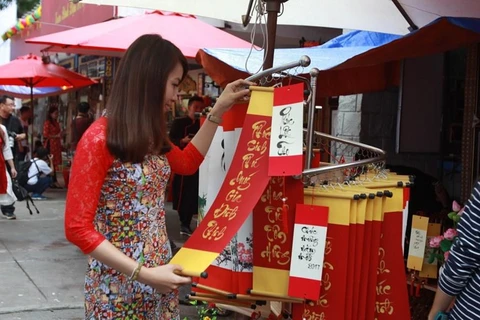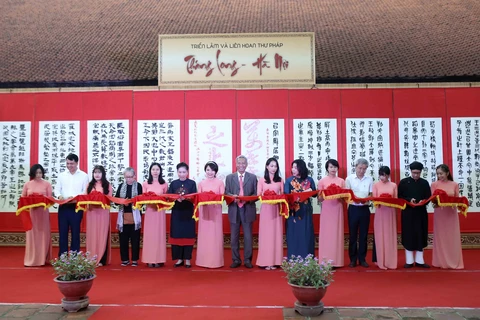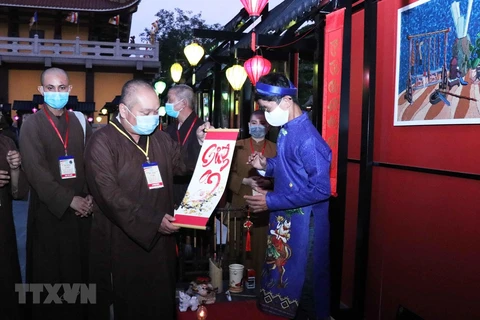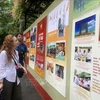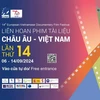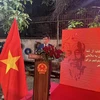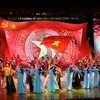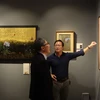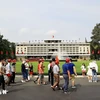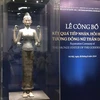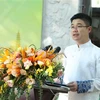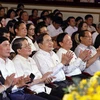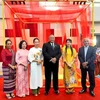 A local resident seeks calligraphic works from an elderly intellectual (Photo: Khanh Hoa/Published by VNA)
A local resident seeks calligraphic works from an elderly intellectual (Photo: Khanh Hoa/Published by VNA) Hanoi (VNA) - Easy to read and understand, Vietnamese calligraphy is a lot simpler to understand than the Han Chinese version, which helped boost its popularity during Tet (Lunar New Year) holiday.
The tradition of collecting letters has become part of Vietnamese culture whenever Lunar New Year arrives. The calligraphic works, which can be romanised Vietnamese, Han Chinese or Nom (Vietnamese ideographic) scripts written by elderly scholars, expresses the Vietnamese people’s respect for knowledge. A word is a spiritual present from the calligrapher, often a Confucian scholar, and conveys New Year wishes to the recipient. The most preferred words symbolize blessing, happiness, longevity, peace, virtue, and prosperity.
The scripts are written on traditonal ‘do’ (poohnah) paper and become symbols of good fortune.
Many calligraphers who are able to write both Vietnamese and Han-Nom calligraphy received increasing orders for Vietnamese calligraphy this year.
According to calligrapher Cung Khac Luoc, seeking calligraphic words from elderly scholars is an act showing people’s desire of a peaceful, lucky and prosperous year. Each calligraphic work is an intersection of a scholar’s wisdom and calligraphic word seeker’s soul.
In addition to using the traditional brushes, red paper and Chinese ink, calligraphy is now done on other materials such as wood, stone, bamboo and silk. The Confucian scholars include old men in traditional long dress and headgear but also young people and women. Each word embodies the soul, knowledge, and personality of the calligrapher.
According to tradition, people often ask for good words to hang in their home in the hope of a new year with good health, peace, happiness and luck.
Depending on the purpose and age of the recipients, the calligraphers will advise them with appropriate words.
Typically, students and youngsters often ask for the characters symbolising 智 (wisdom), 明 (bright) or 達 (achievement), to remind themselves of the importance of attaining knowledge and striving for good results in examinations. The middle aged tend to select 安 (peace), 福 (blessing), 德 (virtue) or 心 (heart), looking forward to a new year of peace and harmony in the family.
In addition to Han and Nom templates, verses and words in Vietnamese are also preferred by many people as they are easy to read and understand.
Good wishes for a happy new year are incorporated in the flexible characters. Because of this, every word printed by the hands of calligraphers is not just a form of but also reveals the heart, personality, spirit and creativity of each scholar.
In the past, calligraphers were often wise and knowledgeable scholars with famous virtues. The recipients hope that through their work that they will also enjoy good luck, mercy and talent from the word givers.
When printing the characters, calligraphers explain the meaning of each letter for receivers so that they can fully understand the profound meaning of each word, thereby understanding more about the cultural custom of the nation.
Before and during the lunar New Year, calligraphists gather outside the temple and write wishes in Han (Chinese script) and Nom (Vietnamese ideographic script) characters. These works of art are given away as gifts, or are used as home decorations on special occasions.
On each occasion of the Lunar New Year, thousands of people from all over the country flock to the Temple of Literature in Hanoi seeking a blessing from Confucian scholars.
In recent time, the Centre for Scientific and Cultural Activities of Temple of Literature co-operates with the Hanoi Department of Culture and Sports to organise the festival each year at Van (Literature) Lake next to the Temple of Literature. The annual cultural event aims to honour Vietnamese tradition and respect for knowledge, along with preserving and promoting the value of Vietnamese calligraphy./.
